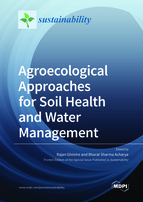Agroecological Approaches for Soil Health and Water Management
A special issue of Sustainability (ISSN 2071-1050). This special issue belongs to the section "Sustainable Agriculture".
Deadline for manuscript submissions: closed (31 August 2021) | Viewed by 59949
Special Issue Editors
Interests: ecohydrology; mining hydrology; irrigation; soil and water management
Special Issues, Collections and Topics in MDPI journals
Interests: soil carbon sequestration, soil health, sustainable agriculture, nutrient cycling, soil organic matter, greenhouse gas emissions
Special Issues, Collections and Topics in MDPI journals
Special Issue Information
Dear Colleagues,
Soils sustain our food systems, regulate the flow of freshwater, store vast quantities of carbon and nutrients, and support numerous organisms. Innovations in agricultural technologies in the last century that have been centered on maximizing food production to feed the growing population have contributed to significant changes in agroecosystem processes, including carbon, nutrients, and water cycling. There is growing concern regarding soil fertility depletion, soil carbon loss, greenhouse gas emissions, irrigational water scarcity, and water pollution, consequently affecting soil health, agricultural productivity, system sustainability, and environmental quality. An improved understanding of biochemical pathways of soil organic matter and nutrient cycling, microbial community involved in regulating soil health, and soil processes associated with water flow and retention in soil profile will help in designing better agricultural systems and ultimately support plant growth and productivity. Agroecological approaches in soil and water management can provide, maintain or enhance multiple ecosystem services, including carbon sequestration, nutrient and water cycling, greenhouse gas mitigation, and ultimately create a sustainable agro-environment.
This Special Issue will present a collection of original research and review papers, which study the physical, chemical, and biological processes that occur in soils under diverse agroecosystems. We will cover topics related to tillage, nutrients, irrigation, amendments, crop rotations, crop residue management with reference to soil health, soil C and nutrient cycling, greenhouse gas emissions, soil water dynamics, and hydrological processes. We also cover topics that discuss impacts and implications of natural processes and anthropogenic effects, such as climate change, drought, and other forms of environmental stresses on soil and water dynamics and agricultural sustainability.
Prof. Rajan Ghimire
Dr. Bharat Sharma Acharya
Guest Editors
Manuscript Submission Information
Manuscripts should be submitted online at www.mdpi.com by registering and logging in to this website. Once you are registered, click here to go to the submission form. Manuscripts can be submitted until the deadline. All submissions that pass pre-check are peer-reviewed. Accepted papers will be published continuously in the journal (as soon as accepted) and will be listed together on the special issue website. Research articles, review articles as well as short communications are invited. For planned papers, a title and short abstract (about 100 words) can be sent to the Editorial Office for announcement on this website.
Submitted manuscripts should not have been published previously, nor be under consideration for publication elsewhere (except conference proceedings papers). All manuscripts are thoroughly refereed through a single-blind peer-review process. A guide for authors and other relevant information for submission of manuscripts is available on the Instructions for Authors page. Sustainability is an international peer-reviewed open access semimonthly journal published by MDPI.
Please visit the Instructions for Authors page before submitting a manuscript. The Article Processing Charge (APC) for publication in this open access journal is 2400 CHF (Swiss Francs). Submitted papers should be well formatted and use good English. Authors may use MDPI's English editing service prior to publication or during author revisions.
Keywords
- Agroecosystem management
- Climate change
- Greenhouse gas emissions
- Hydrological processes
- Nutrient cycling
- Nutrient management
- Organic matter
- Soil carbon cycling and sequestration
- Soil health
- Soil microbial community
- Soil–plant–environment interaction
- Sustainable cropping systems
- Water management






